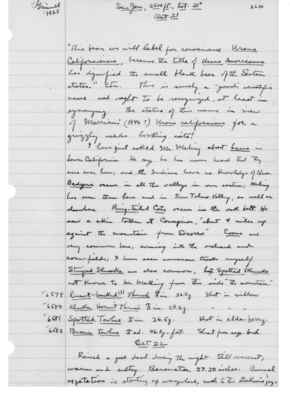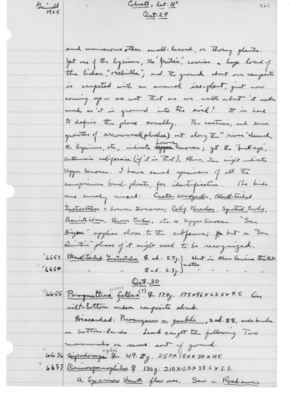Pages That Mention Spotted Towhee
1925: Joseph Grinnell's field notes
S3 Page 53
Collector: Grinnell - 1925 Location: San Jose, 2500 ft., Lat. 31 degrees Date: October 19, 1925 Page Number: 2596
There was a little seepage there, and some rainwater in granite bowls in the stream-course. Large numbers of Valley Quail centered there. The following are the birds I saw, by individuals, from memory; but there were so few, I believe I am close & correct. Red-shafted Flicker (2); San Lucas Flycatcher (1, shot); Calif Jay (10±) Audubon Warbler (16±); Ruby-crown Kinglet (1); Spotted Towhee (5); Brown Towhee (4); Green-backed Goldfinch (1); Lawrence Goldfinch (1, seen and heard in flight overhead); Intermediate Sparrow (20±); Bell Sparrow (2); Calif. Thrashers (3); Shrike (one, very shy, seen and heard repeatedly, but refused to be stalked); Bewick Wren (3); Rock Wren (2); Valley Quail (40±). Horseback is a good way of taking a census, as it increases the range of vision, though chances of hearing high-pitched voices are less because of the squeakings of the saddle, rattle of the bit-chain, etc. I rather think that a foot in most productive, as a person can stop instantly, in perfect quiet, and listen and look; while the horse takes time to come to a standstill and even then fidgets. Of mammals, I saw one Jack Rabbit, and one Bush Rabbit, the latter, as usual in Adenostoma bush. Large bare areas in the mesa, adjacent to sage-bush and juniper, showed great amounts of Dipodomys sign — of the same sort as where I am trapping, near the ranch; this is of the heermanni or paramintinus kind and not of the agilis brand, it seems to me.
S3 Page 57
S3 Page 57
Collector: Grinnell - 1925 Location: San Jose, 2500 ft., lat. 31° Date: Oct. 21 Page Number: 2600
“This bear we will label for convenience Ursus Californiensis, because the title of Ursus Americanus has dignified the small black bear of the Eastern states.” Etc. This is surely a “good” scientific name and ought to be recognized, at least in synonymy. The status of this name in view of Merriam's (1896?) Ursus Californicus for a grizzly needs looking into!
I have just asked Mr. Meling about bears in Lower California. He says he has never heard that they were ever here; and the Indians have no knowledge of them. Badgers occur in all the valleys in one section; Meling has seen them here and in San Telmo Valley, as well as elsewhere. Ring-tailed Cats occur in the oak belt. He saw a skin taken at Concepcion, “about 4 miles up against the mountain from Socorro.” Coons are very common here, coming into the orchard and corn-fields; I have seen numerous tracks myself.
Striped Skunks are also common, but Spotted Skunks not known to Mr. Meling from this side “the mountain.” 6579 Russet-backed Thrush (female sign) im. 26.8g. Shot in willow. 6580 Alaska Hermit Thrush (male sign) im. 24.2g. “ “ “ 6581 Spotted Towhee (male sign) im. 36.5g. Shot in elder-berry. 6582 Brown Towhee (male sign) ad. 46.0g. in fat. Shot from sage-bush.
Oct. 22 Rained a good deal during the night. Still overcast; warm and sultry. Barometer, 27.20 inches. Annual vegetation in starting up everywhere, much to the stockmen’s joy.
S3 Page 66
Collector: Grinnell - 1925 Location: to Colnett, Sat. 31 degrees Date: Oct. 28 Page Number: 2608
6641 Savannah Sparrow (female sign) im. 16.7g. Shot in salicornia. 6642 “ “ (female sign) im. 16.8.g. Shot on stem of clump of juncus.
Was out early 5:15 to 6:30, and again 9:20 to 11:30, the last time to the beach, the bluff, and the salt flats. Saw following birds: Turkey Vulture (4+); Poorwill (heard calling last evening); Valley Quail (2 large coveys near camp); Cactus Woodpecker (one heard); Say Phoebe (2); Anna Hummer (2, around blossoming Lycium); Brown Towhee (4+); Spotted Towhee (2); Rufous-crowned Sparrow (2); Intermediate Sparrow (12±); Calif. Thrasher (2, singing); Linnet (6±); Wren-tit (4+); Black-Tailed Gnatcatcher (2); Bewick Wren (2); Red-winged Blackbird (a pair visited camp, and others in small companies in flight out in the valley); Raven (within hearing most of the time); Meadowlark (4 or more, out in salt flat); Marsh Wren (common, a dozen or more, in dense mats of Salicornia (unknown 1) sloughs just back of the cobble-stone beach-barrier (which is fully 8 feet higher than the flats inland from it)); Savannah Sparrow (scattered troupes on open ground among small bushes back from the salicornia); Belding and Large-billed Sparrows (on salicornia marshes, not many, the latter also on beach at high-tide line of drift); Pipit (flock of 10± on bare alkali flat); Killdeer (one heard - the only wader, where we saw so many on the beach when we were here in September); Song Sparrow (2, in big juncus clumps up the valley from the salicornia. Of mammals, I saw one Jack Rabbit on salt flat and 2 or more Brush Rabbits.
S3 Page 69
Collector: Grinnell - 1925 Location: Colnett, lat. 31 degrees Date: October 29, 1925 Page Number: 2611
and numerous other small-leaved, or thorny plants. Yet one of the lyciums, the “frutéa,” carries a huge load of the lichen, “orchilla”; and the ground about hour campsite is carpeted with an annual ice-plant, just now coming up - so wet that as we walk about it makes mud as it is ground into the soil! It is hard to define the place zonally. The cactus, and dense growths of arrowweed (pluchea) out along the “river” channel, the lyciums, etc., indicate Lower Sonoran; yet the “buck-eye”, artemisia californica (if it is that), Rhus, etc., might indicate Upper Sonoran. I have saved specimens of all the conspicuous bush plants, for identification. The birds are surely mixed: Cactus Woodpecker, Black-Tailed Gnatcatcher = Lower Sonoran; Calif. Thrasher, Spotted Towhee, Bewick Wren, Brown Towhee, etc. = Upper Sonoran. “San Diegan” applies close to the sub fauna; but a “San Quentin” phase of it might need to be recognized.
6653 Black-Tailed Gnatcatcher (female sign) ad. 5.7g. 6654 “ “ (male sign) ad. 6.3g. Shot in Rhus laurina thickets. mates.
Oct. 30 6655 Perognathus fallax (?) (female sign) 17.4g. 175 x 96 x 23.5 x 4.5 On silt-bottom under composite shrub. Discarded: Peromyscus m. gambeli, 2 ad. (male sign) (male sign), under bushes on bottomlands. Lamb caught the following two mammals on same sort of ground. 6656 Dipodomys agilis (female sign) 49.2g. 257 x 150 x 38 x 115. 6657 Ammospermophilus (female sign) 130g. 210 x 53 x 38.5 x 5.5. A Sparrow Hawk flew over. Saw a Roadrunner
S3 Page 71
Collector: Grinnell - 1925 Location: To San Diego Date: October 31, 1925 Page Number: 2614
6:30 a.m. - Last night’s camp a pleasant one. Fog high, and things dry. Live oaks along the west-flowing (dry) watercourse; chaparral of “San Diegan” type on each hillside. Birds: Wrentits, numerously calling; Spotted Towhee; Linnet; Red-shafted Flicker; Audubon Warbler.
Got under way a little before 7 and reached Ensenada at 8:30. Within 10 miles north on Ensenada got a good view, close ranch, flying thru brush at roadside, of a Pigeon Hawk, fully adult, I am quite sure — dark blue back.
In Ensenada, went to see Goldbaum and his museum. The Governor of B.C., Rodriguez, has built him a very substantial little building, “El Museum Regional”, in which are some atrociously mounted vertebrates, but mostly geological specimens. The only thing I saw of special interest was a mounted Spoonbill (Ajaiah) taken [recently?] on the Hardy River by. Capt. E.W. Funcke.
Continued on to San Diego, 10 to 3:30; not delayed at all by the custom officials on either side the line.
Nov. 1 In San Diego: Last evening I called on Mr. Ingersoll at his house. Found him vigorous, and as enthusiastically interested in birds’ eggs as ever. He and Mr. + Mrs. John Burnham were up in the Sierras the past summer and had taken eggs of many good things, such as Sierra Grouse and Hermit Warbler.




